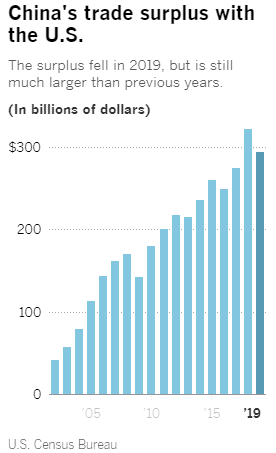The US Still Imposes Heavy Tariffs On Chinese Imports
Despite Market Optimism Triggered By The US-China Phase 1 Trade Agreement, The US Still Imposes Heavy Tariffs On Chinese Imports
“The U.S. remains China’s largest single export market, and China is America’s largest supplier of imported goods. Trump’s trade war hasn’t changed that yet, nor has it seemed to alter the trajectory of the trade relationship for the future. He has just made it more expensive.” (Michael Hiltzik, Trump’s China trade deal doesn’t even get us back to square one, despite the immense cost, Los Angeles Times, Jan. 16, 2020)
As of Jan.15th, China and the US agreed to a partial rollback on tariffs, an expansion of trade purchases, and renewed commitments on intellectual property, technology transfer, and currency practices. The most significant impact of the phase one deal is that it will cut US tariffs and boost China’s purchases of US products.
Nonetheless, the US-China Phase 1 agreement still leaves in place most of the tariffs Trump has imposed on Chinese goods.
Because of the Phase 1 agreement, the Trump administration scrapped the tariffs which were to take effect last month and reaffirmed its commitment to reducing duties from 15 to 7.5% on US$120 billion worth of Chinese products. However, the agreement still leaves tariffs on US$250 billion of China’s products.
China, on its part, agreed to purchase an additional US$200 billion worth of US goods and services over the next two years – above a baseline of US$186 billion purchases in 2017.
Even though President Trump has called the trade deal “transformative,” this view is a complete exaggeration of reality. In fact, the agreement still leaves in place most of the tariffs Trump has imposed on Chinese goods since 2018, which means that most of the retaliatory tariffs by China also continue to remain.
And notwithstanding Trump’s mantra that the tariffs are paid for by the Chinese exporters, virtually all experts conclude that the tariffs are paid entirely by Americans.
Even after the agreement, the average US tariff on China imports will still be 19.3%, a modest reduction from the pre-agreement level of 21% and more than six times its level of 3% before Trump launched the tariff war.
Under the phase one deal, China commits to over the next two years importing an additional $200 billion in new purchases of agricultural and manufactured goods, services, and crude oil and other energy.
However, there are widespread doubts that China can actually absorb increased imports on such a scale. Moreover, there is also the question of how its higher import commitments can be monitored and enforced.




